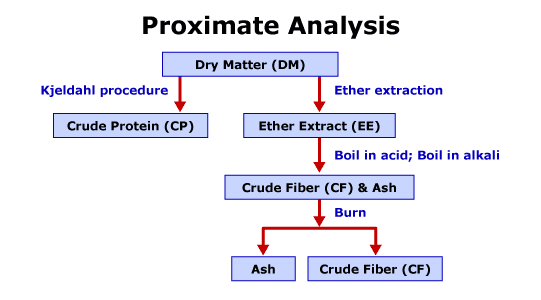|
|
 |
| Welcome | Getting Started | Resources | Site Map |
Week 1
Feedstuffs and Nutritional Value |
Instructions for listening to audio clips
- Download the QuickTime Player to listen to the audio files.
- Read the QuickTime Instructions for installation help.
- Download the RealPlayer to listen to the audio files
- Instructions are on the RealPlayer download page
Laboratory-Based Analyses
Follow along with the audio...
- Objective
- Measure amount of each component (nutrient) in feedstuff
- Accurate quantitative measurement
- Procedures
- Proximate analysis
- Figure 3.6 – Diagram of proximate analysis
- Dry matter (DM)
- Estimates quantity of dry matter and moisture content
- Crude protein (CP)
- Estimates quantity of protein and nonprotein nitrogen compounds
- Kjeldahl method to estimate nitrogen
- Nitrogen converted to CP
- Equation: % CP = Nitrogen x 6.25
- Ether extract (EE)
- Estimates quantity of organic solubles; lipids
- Ash
- Estimates quantity of inorganics; minerals
- Crude fiber (CF)
- Estimates quantity of fiber associated components, i.e. cellulose, hemicellulose, and lignin
- Unsatisfactory; replaced by detergent fiber analysis
- Nitrogen-free extract (NFE)
- Estimates nonfibrous carbohydrates
- Calculation
- %NFE = 100 % DM –
- Detergent fiber system
- Figure 3.7 – Diagram of detergent fiber system
- More accurately estimates CHO fractions
- Estimates of fibrous CHO
- Neutral detergent fiber (NDF)
- Primarily: hemicellulose, cellulose, and lignin
- Acid detergent fiber (ADF)
- Primarily: cellulose and lignin
- Estimates of nonfibrous CHO
- Nonfibrous carbohydrates (NFC)
- Calculated
- %NFC = 100 % DM –
- Gross energy (GE)
- Estimates total chemical energy
- Figure 3.8– Diagram of bomb calorimeter
- Inconsistent measure of energy available
- Used with additional procedures
- Specialized procedures
- High performance liquid chromatography (HPLC)
- Identify amino acids
- Atomic absorption spectrophotometry
- Identify minerals
- Near-infrared reflectance spectroscopy (NIRS)
- Standard analyses
- Gas-liquid chromatography (GLC)
- Identify gaseous compounds and compounds able to be vaporized



| |
| Welcome | Getting Started | Resources | SiteMap |